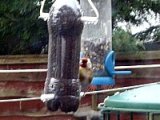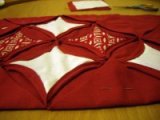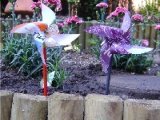Beginning Quilting?
Hope This Helps x
If you are just beginning quilting then this section is the place for you. I'm a beginner myself so you are in good company.
Quilting can be an easy and effective way to recycle old clothes or bedding that you no longer use. Keeping scraps of material is how lots of women used to make their quilts and because they were so skilled many old quilts are still passed down from generation to generation.
Anyway, as I was saying, quilting is so versatile as you can make a beautiful piece from scraps of material that you have collected, instead of them going to waste or landfill.
The art of quilting is really combined into a few separate skills.
The Piecing Bit
First - and my favorite - is the piecing bit. This is where you begin quilting by deciding how all your scraps are going to fit together and sewing them up. In England this is generally referred to as patchwork. Quilters use different methods depending on their favorite and the pattern they are sewing, here are some that I have been trying
- English Paper Piecing
- Paper/fabric foundation piecing
- Machine piecing
- Strip piecing
Click on the links and have a go at them all! (it's work in progress so please be patient while I write more pages) When you are beginning quilting it's important to find a way of working that suits you. If you like hand sewing then English paper piecing could be the way forward. I love to hand sew of an evening when I canÕt be bothered getting my machine out and I just want to sit and relax. I have put together some of my favorite paper piecing quilting projects for you to try so enjoy.
Paper foundation piecing is done on a sewing machine and is great if you don't want to have to cut out accurate pieces of material. On the paper foundation piecing projects page you will find some free beginners quilting patterns. I've also included some links to other sites where you will find hundreds of patterns to keep you busy.
Machine piecing is a good method if you are accurate when you cut out your material. You can get a lot done very quickly if you practice. I don't do this much! Read what you like into that x
Strip or chain piecing involves sewing long strips of material together and then cutting them to form squares. They are then sewn together into various patterns to form blocks.
The Quilting Bit
After you have pieced all your scraps together then you do the actual quilting. The pieced part is the top, you then add batting and sandwich that between the top and the backing. Using quilting stitch you then sew all the way through the three layers to construct the quilt.
Again you can do this in quite a few ways.
- Quilting in the ditch
- Traditional quilting
- Trapunto
- Applique
- Last but by no means least - because it's my favorite - is cathedral window quilting.
I have fallen in love with this quilting method! If you are beginning quilting this is a good place to start. It's mostly hand sewn so that's a big consideration but unlike traditional quilts there is only one layer (although you can include batting). This makes for a very satisfying quilt, it grows as you sew and because the pieces are made as soon as you sew them together you can almost quilt as you go and stop when you want!
Ok if you are a very experienced quilter I dare say you have spotted a bit of over simplification and some methods haven't been mentioned at all. This page is designed for those beginning quilting as a way of recycling. I hope when I have more experience I will add more pages for more experienced quilters but in the meantime I hope that even if you have been quilting for years you will enjoy these new ideas.







